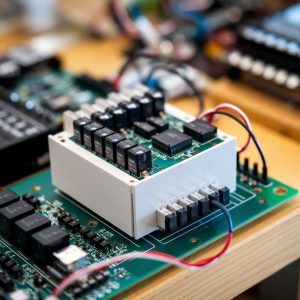Items of № 12−2, 2024
Hybrid communication: opportunities and prospects
R.V. Kirichek, The Bonch-Bruevich Saint-Petersburg State University of Telecommunications (SPbSUT), rector, professor, Dr.Sci.(Tech.); kirichek@sut.ru
A.V. Abilov, SPbSUT, first vice-rector – vice-rector for education, associate professor, Ph.D.; education@sut.ru
A.V. Rabin, SPbSUT, acting vice-rector for research, director of the centre for special projects, Dr.Sci.(Tech.); rabin.av@sut.ru
A.I. Zaitsev, SPbSUT, vice-rector for digital transformation and administrative work; zaitsev.ai@sut.ru
D.V. Okuneva, SPbSUT, vice-rector for project activities, Ph.D.; okuneva.dv@sut.ru
D.N. Zastolbin, SPbSUT, vice-rector for security; bp@sut.ru
Abstract. The paper presents the results of an analysis of modern challenges facing the Russian Federation economy in general and the communications industry in particular. The problems that can be solved with the help of hybrid communication networks, foreign and domestic approaches and technical solutio ns are considered. Particular attention is paid to the role of higher educational institutions in solving these problems.
Keywords: hybrid communications, hybrid networks, satellite communication systems, satellite constellation, orbital segment, ground segment.
Load balancing in an SDN network using MEC technology
A.N. Gavrilova, The Bonch-Bruevich Saint-Petersburg State University of Telecommunications (SPbSUT), graduate student; gavrilova.an@sut.ru
V.S. Elagin, SPbSUT, department of infocommunication systems, associate professor, Ph.D.; v.elagin@sut.ru
Abstract. The paper discusses methods of load balancing in software-defined networks (SDN) based on Mobile Edge Computing (MEC) technology. An ant algorithm is modified, where each agent is responsible for finding a migration plan in parallel for all virtual machines, and the results of applying this algorithm in an SDN network are analyzed. In addition, the paper proposes a new approach for estimating server workload indicators, which aims to improve the efficiency of load balancing using the proposed ant algorithm by implementing an integrated control architecture using NFV (Network Function Virtualization) technology based on a thickened tree topology.
Keywords: ant colony optimization, MEC technology, SDN network, NFV technology.
Integration model of adaptive algorithm for selecting and changing blockchain consensus at boundary values of network indicators
A.V. Pomogalova, The Bonch-Bruevich Saint-Petersburg State University of Telecommunications (SPbSUT), senior lecturer; pomogalova.av@sut.ru
E.A. Donskov, Saint-Petersburg Institute for Informatics and Automation of the Russian Academy of Sciences, Laboratory of computer security problems, postgraduate; radion2002@gmail.com
V.S. Elagin, SPbSUT, acting dean, associate professor, Ph.D.; v.elagin@sut.ru
Abstract. The paper considers a mathematical description of the model of an adaptive algorithm for selecting and changing the consensus of a blockchain network when certain network conditions occur. The paper presents an analysis of the structure of a packet containing blockchain network traffic, as well as a calculation of the average network load when transmitting transaction blocks over the network. The paper provides boundary values of network indicators, as well as the most effective consensus algorithms for ensuring uninterrupted transaction processing in various network conditions. The results of analytical calculations and experimental modeling are presented, demonstrating the effectiveness of the proposed approach.
Keywords: blockchain, consensus algorithm, adaptive consensus selection algorithm, efficiency, DLT.
Frequency-energy efficiency of the use of discrete symmetric communication channels when using BCH codes
D.S. Kukunin, The Bonch-Bruevich Saint-Petersburg State University of Telecommunications (SPbSUT), department of communication networks and data transmission, associate professor, Ph.D.; kukunin.ds@sut.ru
V.I. Bobrovsky, SPbSUT, department of software engineering and computer engineering, professor, Dr.Sci.(Tech.); bobrovskii.vi@sut.ru
R.V. Kirichek, SPbSUT, rector, professor, Dr.Sci.(Tech.); kirichek@sut.ru
Abstract. The paper investigates the frequency-energy efficiency of using discrete channels with constant parameters, additive white Gaussian noise, and optimal coherent reception when using signal structures with binary amplitude, frequency, and phase manipulation. Special attention is paid to the issues of the joint application of these types of modulation and noise-resistant BCH codes.
Keywords: frequency-energy efficiency, modulation, noise-resistance coding, BCH codes.
Masking encrypted FPV video stream when controlling UAVs. Part I. Models and methodology
А.A. Berezkin, The Bonch-Bruevich Saint-Petersburg State University of Telecommunications (SPbSUT), associate professor, Ph.D.; berezkin.aa@sut.ru
A.A. Chenskiy, SPbSUT, masters student; chenskii.aa@sut.ru
R.V. Kirichek, SPbSUT, rector, professor, Dr.Sci.(Tech.); kirichek@sut.ru
Abstract. To reduce network delays and packet losses during FPV control of unmanned aircraft systems via packet data networks, it is necessary to ensure a high degree of compression of video stream frames. For this purpose, an approach based on the use of variational autoencoders and subsequent quantization and compression of video stream frames in the internal latent feature space of the neural network is actively used. This paper presents the development of this approach, which consists in masking a binary sequence obtained from the values of the latent feature space of the neural network autoencoder. The first part of the article describes the technique of masking the values of the latent feature space, presents methods for restoring masked values based on direct propagation neural networks and regression models, and describes the experimental technique.
Keywords: variational autoencoder, quantization, neural networks, masking, video stream compression, FPV control, UAVs, unmanned aerial systems.
Research of multimedia traffic, Internet of Things and holographic services on a model network
M.A. Makolkina, The Bonch-Bruevich Saint-Petersburg State University of Telecommunications (SPbSUT), head of the department of information and communication systems, Dr.Sci.(Tech.); makolkina.ma@sut.ru
N.A. Demidov, SPbSUT, postgraduate; iks_1930@sut.ru
Abstract. The article presents an experimental study of new types of traffic on the SPbSUT model network, including traffic of multimedia services, the Internet of Things, and holographic services. Based on the data obtained, analytical models were developed. Then, simulation modeling of these types of traffic and a comparison of the developed models were carried out. Based on the results of the study, the structure of multimedia traffic, the Internet of Things traffic, and holographic services was determined, which will allow for further reasonable planning of fifth-generation and subsequent-generation networks.
Keywords: holographic conferencing, multimedia traffic, Internet of Things traffic, holographic traffic, holographic type communication, model network.
Development of an automatic portable electroencephalograph with the possibility of integration into a Unified Information System of the Arctic zone of the Russian Federation
A.B. Stepanov, The Bonch-Bruevich Saint Petersburg State University of Telecommunications, Institute of Master’s Studies, deputy head of education, associate professor, Ph.D.; stepanov.ab@sut.ru
Abstract. The paper is devoted to developing the concept of the Unified Information System of the Arctic Zone of the Russian Federation and designing an automatic portable electroencephalograph with the possibility of integration into this system. The author proposes mathematical models of wavelets for continuous wavelet transform adapted to the analysis of an electroencephalogram and presents a two-stage system of electroencephalogram analysis, which allows identifying about 80% of artifacts and pathological components in the signal. The paper also provides the results of testing the prototype of an automatic portable electroencephalograph and elements of the Unified Information System of the Arctic Zone of the Russian Federation.
Keywords: automatic portable electroencephalograph, wavelets, synthesized wavelets, mathematical models of wavelets, hybrid link networks, artificial neural networks, transceivers, LoRa technology.
Method for detecting intruder WLAN access points in a distributed personal data information system
M.V. Kovzur, The Bonch-Bruevich Saint-Petersburg State University of Telecommunications (SPbSUT), associate professor, Ph.D.; zss_ibks@sut.ru
D.V. Sakharov, SPbSUT, associate professor, Ph.D.; zss_ibks@sut.ru
E.V. Birikh, SPbSUT, senior lecturer; zss_ibks@sut.ru
V.E. Drepa, SPbSUT, student; zss_ibks@sut.ru
Abstract. A method is developed for automated detection and blocking of intruder access points in a distributed personal data information system, which allows reducing the response time and eliminating the consequences of a computer incident caused by the installation of an intruder access point. A computational assessment and experimental verification of the efficiency of the proposed method were carried out. The developed approach is presented in the form of an algorithm capable of automatically identifying intruder access points connected to the corporate infrastructure and promptly disabling them.
Keywords: intruder, personal data information system (PDIS), WLAN, Wi-Fi, intruder access point (IAP), detection of an illegal access point, Ansible, IEEE 802.11, information security (IS), network administration.
Implementation of the adaptive beamforming algorithm with correlation matrix inversion on FPGA
E.I. Glushankov, The Bonch-Bruevich Saint Petersburg State University of Telecommunications (SPbSUT), professor, Dr.Sci.(Tech.); glushankov.ei@sut.ru
K.O. Korovin, SPbSUT, associate professor, Ph.D.(Phys.-Math.); korovin.ko@sut.ru
I.A. Boyko, SPbSUT, assistance lecturer; boiko.ia@sut.ru
Abstract. The paper is devoted to the FPGA implementation of a beamforming algorithm in adaptive antenna arrays in multisignal reception mode. A mathematical description of the adaptive signal processing procedures, providing the optimal approximation of the input influence to the sample signal according to Wiener’s algorithm, is given. Approximate methods providing practical realization of beamforming in a multisignal mode based on iterative algorithms of correlation matrix reversal are considered, and the convergence analysis of these algorithms is given. The results of constructing an 8-element antenna array with double linear polarization of radiation and a uniform radiation pattern in the range of operating angles are presented. The resulting radiation patterns of the antenna array in an anechoic chamber, providing adaptive signal processing, are given. The results of in-situ experiments show an acceptable coincidence of theoretical and experimental data.
Keywords: adaptive antenna array, radiation pattern, Wiener algorithm, Newton algorithm, Chebyshev algorithm, modified Newton algorithm, FPGA.
Optimization of WorkForce management strategy of 5G network operator
M.A. Fenomenov, The Bonch-Bruevich Saint-Petersburg State University of Telecommunications, senior lecturer; Fenomenov.ma@sut.ru
Abstract. A method for optimizing the strategies of workforce management (WFM) for a telecom operator is proposed. The method is based on the calculation of probabilistic and temporal characteristics of the performance of commissioning, repair, and maintenance work by personnel of a modern multiservice post-NGN communication network with a guaranteed execution period. A numerical example of WFM optimization in a real project for launching a Private-LTE network in an enterprise is given.
Keywords: OSS/BSS (Operation Support System/Business Support System), WFM (Workforce Management), SLA (Service Level Agreement), key performance indicators, KPI, probabilistic characteristics.
Assessing the digital technologies impact on innovation business-models of telecommunication systems
A.A. Sherstneva, The Bonch-Bruevich Saint-Petersburg State University of Telecommunications, department of infocommunication systems, associate professor, Ph.D.; sherstneva@sut.ru
- Zhang, National Research Tomsk State University, postgraduate; iks_1930@sut.ru
Abstract. In this paper, the authors use regression analysis to study the impact of digital technologies on the innovative component of business models for telecommunication systems. Panel data of Chinese listed firms is used as the research sample. Heteroscedastic data processing is performed to control for individual differences in the research sample. The study shows that entrepreneurship in the manufacturing and telecommunication services sectors has a significant positive impact on telecommunication system’s innovative business models and digital transformation plays an indirect role in the relationship between these aspects. The scientific novelty of this study lies in identifying the different impacts of production and service infrastructure and digital transformation on innovative business models. Empirical data are obtained for various manufacturing companies that make it possible to formulate strategies in innovative business modeling and use the potential of business model innovation. A number of analytical models are proposed to identify the role of digital transformation in the relationship between telecommunication equipment vendors, managerial entrepreneurship and business model innovation. A number of key variables are identified in the developed analytical models. A qualitative comparative analysis was performed on the key variables. The results of the analysis were processed using regression methods and summarized in informative tables. The corresponding conclusions were made on the indirect impact of digital transformation on business model innovation.
Keywords: infocommunication, VUCA, digital transformation, regression analysis, business model innovation.









